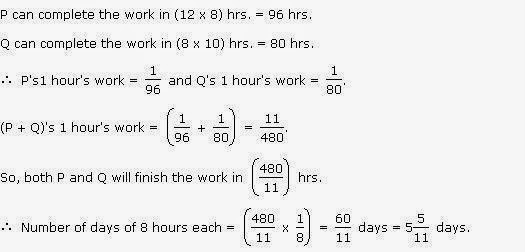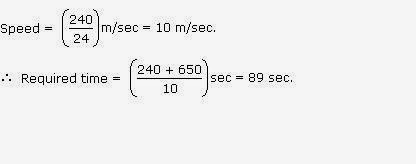Monday 21 July 2014
A machine P can print one lakh books in 8 hours, machine Q can print the same number of books in 10 hours while machine R can print them in 12 hours. All the machines are started at 9 A.M. while machine P is closed at 11 A.M. and the remaining two machines complete work. Approximately at what time will the work (to print one lakh books) be finished ?
A machine P can print one lakh books in 8 hours, machine Q can print the same number of books in 10 hours while machine R can print them in 12 hours. All the machines are started at 9 A.M. while machine P is closed at 11 A.M. and the remaining two machines complete work. Approximately at what time will the work (to print one lakh books) be finished ?
A. 10:40 A.M. B. 1:22 p.m.
C. 11:20 P.M. D. 1:00 P.M.
Answer: D
Explanation:
A alone can do a piece of work in 6 days and B alone in 8 days. A and B undertook to do it for Rs. 3200. With the help of C, they completed the work in 3 days. How much is to be paid to C?
A alone can do a piece of work in 6 days and B alone in 8 days. A and B undertook to do it for Rs. 3200. With the help of C, they completed the work in 3 days. How much is to be paid to C?
Options:
A. Rs. 325 B. Rs. 400
C. Rs. 200 D. Rs. 450
Answer:B
Explanation:
Two stations A and B are 110 km apart on a straight line. One train starts from A at 7 a.m. and travels towards B at 20 kmph. Another train starts from B at 8 a.m. and travels towards A at a speed of 25 kmph. At what time will they meet?
Two stations A and B are 110 km apart on a straight line. One train starts from A at 7 a.m. and travels towards B at 20 kmph. Another train starts from B at 8 a.m. and travels towards A at a speed of 25 kmph. At what time will they meet?
Options:
A. 10 a.m. B. 10 a.m.
C. 9.39 a.m. D. 12 a.m.
Answer: B
Explanation:
Options:
A. 10 a.m. B. 10 a.m.
C. 9.39 a.m. D. 12 a.m.
Answer: B
Explanation:
A train overtakes two persons walking along a railway track. The first one walks at 4.5 km/hr. The other one walks at 5.4 km/hr. The train needs 8.4 and 8.5 seconds respectively to overtake them. What is the speed of the train if both the persons are walking in the same direction as the train?
A train overtakes two persons walking along a railway track. The first one walks at 4.5 km/hr. The other one walks at 5.4 km/hr. The train needs 8.4 and 8.5 seconds respectively to overtake them. What is the speed of the train if both the persons are walking in the same direction as the train?
Options:
A. 88 km/hr B. 59 km/hr
C. 44 km/hr D. 81 km/hr
Answer: D
Explanation:
Options:
A. 88 km/hr B. 59 km/hr
C. 44 km/hr D. 81 km/hr
Answer: D
Explanation:
Sunday 20 July 2014
A train travelling at a speed of 75 mph enters a tunnel 31/2 miles long. The train is 1/4 mile long. How long does it take for the train to pass through the tunnel from the moment the front enters to the moment the rear emerges?
A train traveling at a speed of 75 mph enters a tunnel 31/2 miles long. The train is 1/4 mile long. How long does it take for the train to pass through the tunnel from the moment the front enters to the moment the rear emerges?
Options:
A. 2.1 min B. 3 min
C. 3.5 min D. 3.9 min
Answer: B
Explanation:
Options:
A. 2.1 min B. 3 min
C. 3.5 min D. 3.9 min
Answer: B
Explanation:
Subscribe to:
Posts (Atom)











































